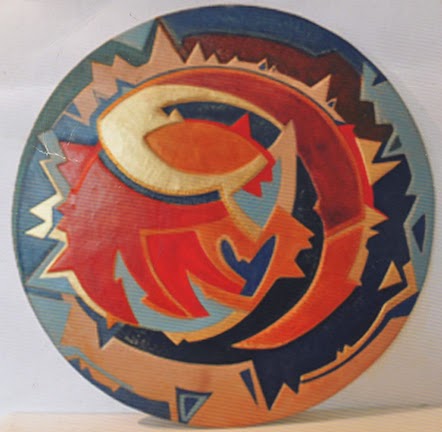 |
| Artist J.Bayarjargal (2nd from right) with her final student art project. |
Mongolian Christian artist J.Bayarjargal is a recent art school graduate from the Mongolian University of Arts and Culture in Ulaanbaatar. For her final project she created a series of seven leather disks based on the days of creation (and the first Sabbath) found in Genesis.
Bayarjargal has been a follower of Christ since 2006. For her final art project, she wanted to create something that was a testimony to her professors about her faith in God's Son. She says, "There is only one inspiration for my artwork [and] that is God and His mighty work that He has done for us." She chose leather as her medium because her brother, who is also an artist, had previously worked with leather.
The round shape of Bayarjargal's leather pieces represents God's omnipotence, omniscience, and omnipresence. She reinforces the idea of God's unchanging nature through the use of three colors throughout the seven disks: red, yellow and blue. These are also the colors of the Mongolian flag. Bayarjargal writes that red represents strength, decisiveness and power; blue signifies the eternal blue sky, with the different shades of blue in the leather disks symbolizing "the limitlessness of God in all areas." Yellow equals clarity and light. Using the same palette throughout the seven discs indicates that "everything [is] connected [and] related to one another [because of] the way He created them."
The style of the shapes in the work is influenced by southwestern Native American art because these cultures are "connected" to Mongolians and Bayarjargal feels that their art seems to represent "a time of long ago," an idea which connects southwestern art to the the beginning of creation and to Bayarjargal's artwork. Looking at her leather pieces, I'd say she definitely put her own spin on most of the designs that she created, rather than only using existing southwestern designs and motifs. Some of it reminds me of southwestern silver jewelry as well, though again, not exactly.
 |
| J.Bayarjargal, Day 1– Light. Leather on wood, 15.75" |
In the first piece, Light, the central yellow disk shows light appearing where before there was only empty darkness. The yellow disk and its background is also intentionally shaped to remind the viewer of an embryo, symbolizing Christ coming as the Light of this dark world.
 |
| J.Bayarjargal, Day 2– Heavens/Space. Leather on wood, 15.75" |
 |
| J.Bayarjargal, Day 3– Plants. Leather on wood, 15.75" |
 |
| J.Bayarjargal, Day 4– Sun & Moon. Leather on wood, 15.75" |
 |
| J.Bayarjargal, Day 5– Fish. Leather on wood, 15.75" |
Two swimming fish are depicted from above in Fish. Bayarjargal chose to depict fish because they represent the first animals that God created– sea creatures– and because fish are biblically symbolic: the two fish are depicted as a pair because God created both male and female animals; and, Christ performed the miracle of the two fish and five loaves which can represent multiplication and growth.
According to Bayarjargal, in traditional Mongolian art the two fish (symbolic of alertness) form a yin-yang symbol and can represent the making of merit to balance one's bad deeds. She wanted to avoid that religious association because God's original creation was "all good", not "bad and good".
 |
| J.Bayarjargal, Day 6– Humans. Leather on wood, 15.75" |
Eve's face closely resembles a Zuni sunface:
The Zuni sunface represents the sun as a deity. The forehead is usually split into two (sometimes three) sections which represent the individuality of a person as well as their role as part of their family. The two sections can also represent sunrise/sunset or day/night. Regarding the slit-shaped eyes, Turquoise Canyon writes, "The Zuni do not add detail to the eyes for reasons of respect. The eyes are “windows of the soul” and as such an artist cannot assume to know what lies within. Therefore they are represented by the black rectangles." For more info on the Zuni sunface symbol, click here or here.
 |
| J.Bayarjargal, Day 7– Rest. Leather on wood, 27.5" |
A cross envelops the final design, Rest, like a stamp certifying God's completion of His work of creation and subsequent rest. It also recalls Christ's statement "It is finished" as He completed His work of redemption on the cross. Bayarjargal wanted to show that only Christ can give us rest for our souls. This piece is the biggest of the grouping because it binds all the smaller pieces together just as Christ is the one holding all things together (Colossians 1:16-17).


No comments:
Post a Comment